Dog Gait or Movement Terminology
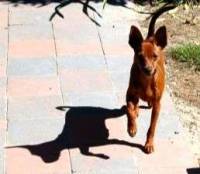 Miniature Pinscher
Miniature Pinscher
Gait or movement is the crucial test of conformation. This section begins with a balanced trot and then describes two extremes. Then we have movement variations - the Miniature Pinscher with its hackney gait, the Old English Sheepdog with its amble or pace and the Afghan Hound with its style of high order. Lastly the double extension gallop of the Sighthound is explained.
Trot with balanced Reach and Drive
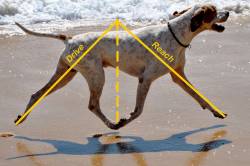 Pointer (English)
Pointer (English)
This Pointer (English) is moving at a balanced trot which is the most common gait required when the dog is being judged at a dog show. This gait requires the reach of the front legs to equal the drive of the back legs while the back or topline remains firm and level.
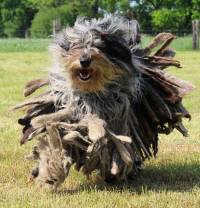 Bergamasco Shepherd Dog
Bergamasco Shepherd Dog
Extended Trot
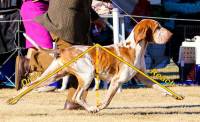 Bracco Italiano
Bracco Italiano
Here we have an exaggerated gait of an 'extended trot'. This term derives its name from the discipline of dressage in horses. It means that the animal has such power in his hindquarters, it is able to generate sufficient forward propulsion to extend its front legs forward to their fullest extension. For example, the Bracco Italiano and the Bergamasco Shepherd Dog (pictured). This movement is correct for these two breeds but is too exaggerated for most others.
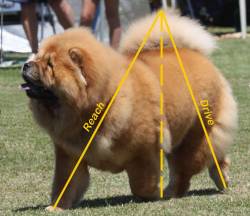 Chow Chow
Chow Chow
Reduced Angulation and 'Stilted Gait' of the Chow Chow
Somewhere between the 'trot with balanced reach and drive' described above are various examples of breeds with a somewhat reduced angulation. An extreme example of this is the Chow Chow whose gait is reduced to a unique stilted gait where the rear movement lacks drive.
The main reason why the Chow Chow's gait is stilted because it has a reduced turn of stifle. Because of this, the back legs can only move in an unnatural pendulum-like straight line, not extending as far forwards or backwards as Pointer (above). But without rolling the body, the hind legs should still have sufficient strength to propel its body weight forwards through its short loin to its front legs. Although correct for the Chow Chow, this gait is incorrect for most other breeds.
'Springy Gait' of the Afghan Hound
The Afghan Hound has another extreme gait described as 'smooth and springy with a style of high order'. The effortless, graceful but unique gait is correctly achieved by the exaggeration of these three components:
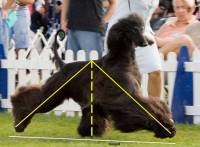 Afghan Hound
Afghan Hound
- Longer bones with more muscle strength in both front and rear assemblies relative to its body weight compared to that of a normally built dog, giving the hound power to have definite spring in its gait.
- Greater reach and drive in both the front and rear assemblies like the 'extended trot' shown above. This requires greater flexibility in the pastern which acts as a shock absorber to cushion the greater reach and drive as well as the spring. When combined with an equivalent flexibility in the hock joint and length from hip to hock, the hound is able to move gracefully and smoothly.
- Higher head and tail carriage compared to a normally built dog, giving the Afghan its proud carriage or 'style of high order'.
'Stealth' of the Border Collie
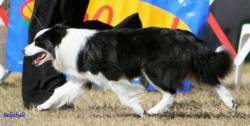 Border Collie's normal balanced gait
Border Collie's normal balanced gait
Some Working dogs, like the Border Collie have low head carriage. Additionally, its movement is described as 'free, smooth, tireless, with a minimum lift of feet, conveying the impression of the ability to move with great stealth'. This is in contrast to the high head carriage and 'style of high order' described Afghan Hound above.
 Border Collie having 'given the eye'
Border Collie having 'given the eye'
But 'stealth' is never seen in the show ring because it requires the dog's focus to be on the animals it is shepherding. At first the dog 'gives eye' or stares at the livestock, challenging them to move in a given direction.
 Border Collie 'moving with stealth'
Border Collie 'moving with stealth'
Once the animals begin to move, the dog follows with a slow, crouching movement called 'stealth' which causes the livestock to continue down the desired path. The smooth coated Border Collie pictured is a working sheepdog rather than a show dog, but is a pure breed dog because it is registered with one of the Working Sheepdog Associations that is recognized in turn with the ANKC.
'Hackney Gait' of the Miniature Pinscher
 Hackney Horse
Hackney Horse
The name 'hackney gait' of the Miniature Pinscher derives its name from the hackney horse on the left. At a trot, this hackney gait is an exaggerated high wrist, knee and hock action due to very good flexion of the joints.
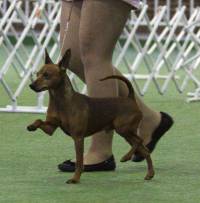 Miniature Pinscher
Miniature Pinscher
This action should be straight and true with a distinct pause or moment of suspension at the top of each stride. The front legs should reach up high with sharply bent wrists that are stretched well forward with ground covering strides. Combine this with a similar high stepping action of the hind legs at the knees that are well propelled underneath the dog with a similar exaggeration, we have the hackney gait. Whilst correct for a Miniature Pinscher, it is incorrect when seen in most other breeds.
High Stepping Front movement of the Italian Greyhound
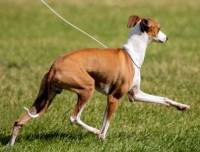 Italian Greyhound
Italian Greyhound
This high stepping action of the Italian Greyhound is different from the hackney gait of the Miniature Pinscher described above. Here the high stepping front action is more of a prancing movement where there is little or no bend at the knees. Additionally there is no pause at the moment of suspension. Nor does the high stepping front action of the Italian Greyhound cause corresponding a high stepping hind action like the Miniature Pinscher illustrated above on the right.
Pace or Amble of the Old English Sheepdog
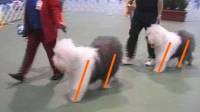 Old English Sheepdogs
Old English Sheepdogs
A pace or amble is when two legs on one side move together and then the two legs on the other side move together. This is in contrast to legs on the same side moving in opposite directions as shown by the balanced reach and drive of the Pointer (English) above.
While this gait is typical of the Old English Sheepdog pictured here, it is incorrect gait for the show ring in most other breeds.
The 'Roll' of the Pekingese and Sussex Spaniel
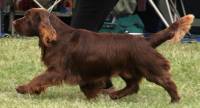 Sussex Spaniel
Sussex Spaniel
The roundness of the Pekingese and Sussex Spaniels' ribcages coupled with their short forearms and the width of chest causes these dogs' weight to shift from side to side or 'roll'.
Double Suspension Gallop of Sight Hounds
This is typical of Sight Hounds like the Deerhound pictured. At full gallop we can see on the left how the front legs extend between the back legs when the dog is in full stride and then reach out again as the picture on the right demonstrates. This action produces a series of gigantic leaps during which the dog becomes totally air borne.
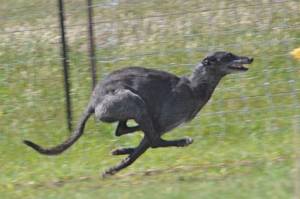 Deerhound
Deerhound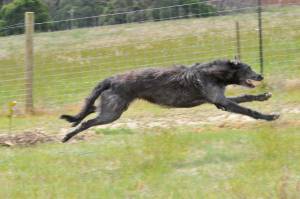 Deerhound
Deerhound
References and Further Reading
Harold R Spira 'Canine Terminology' Harper & Row 1982 Pages 66 - 70